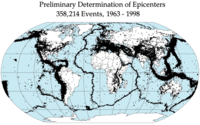
Photo from wikipedia
Recently, most research has been conducted to minimize damage from earthquakes by establishing an early warning system through the analysis of short seismic waves. In particular, deep learning is widely… Click to show full abstract
Recently, most research has been conducted to minimize damage from earthquakes by establishing an early warning system through the analysis of short seismic waves. In particular, deep learning is widely used as it allows to learn complex patterns for earthquake detection from seismic data without complex physical knowledge. In this letter, we propose an improved ConvNetQuake for earthquake event classification by adding learnable features related to the maximum amplitude of the seismic waveform. Since the maximum amplitude is a major factor representing the characteristics of an earthquake, we presented a deep learning structure that can apply this factor in the process of determining whether an earthquake occurs. In the proposed structure, the maximum amplitude is transformed into a feature learned through multi-layer perceptron (MLP) and then concatenates with features extracted through a convolutional neural network (CNN). On the STanford EArthquake Dataset (STEAD) dataset, the proposed method significantly increases the performance for an earthquake event classification than the previous state-of-the-art (SOTA) method by only adding a few parameters.
Journal Title: IEEE Geoscience and Remote Sensing Letters
Year Published: 2022
Link to full text (if available)
Share on Social Media: Sign Up to like & get
recommendations!